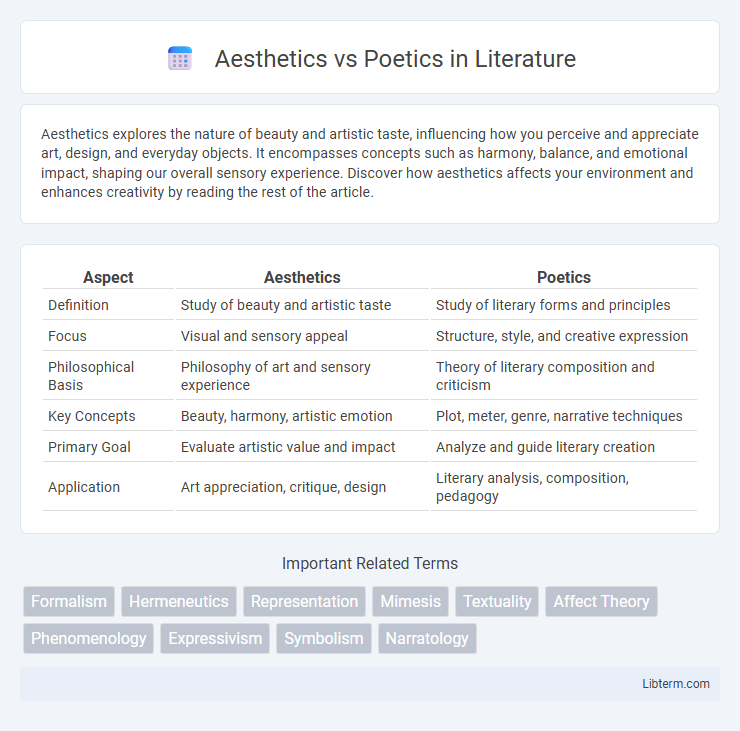Aesthetics explores the nature of beauty and artistic taste, influencing how you perceive and appreciate art, design, and everyday objects. It encompasses concepts such as harmony, balance, and emotional impact, shaping our overall sensory experience. Discover how aesthetics affects your environment and enhances creativity by reading the rest of the article.
Table of Comparison
| Aspect | Aesthetics | Poetics |
|---|---|---|
| Definition | Study of beauty and artistic taste | Study of literary forms and principles |
| Focus | Visual and sensory appeal | Structure, style, and creative expression |
| Philosophical Basis | Philosophy of art and sensory experience | Theory of literary composition and criticism |
| Key Concepts | Beauty, harmony, artistic emotion | Plot, meter, genre, narrative techniques |
| Primary Goal | Evaluate artistic value and impact | Analyze and guide literary creation |
| Application | Art appreciation, critique, design | Literary analysis, composition, pedagogy |
Understanding Aesthetics: Definition and Scope
Aesthetics refers to the philosophical study of beauty, art, and taste, encompassing sensory experiences and emotional responses. It examines the nature and criteria of what makes objects or experiences aesthetically pleasing or significant across various art forms. The scope of aesthetics extends beyond visual art to include music, literature, and everyday experiences, highlighting how perception and cultural context influence aesthetic judgment.
Exploring Poetics: Meaning and Evolution
Poetics, rooted in Aristotle's seminal work, explores the principles and structures underlying literary and artistic expression, emphasizing narrative techniques, genre distinctions, and emotional impact. Its evolution reflects shifts from classical rhetoric to modernist experimentation, highlighting the dynamic interplay between form and meaning in various art forms. Understanding poetics involves analyzing how creators manipulate language, rhythm, and symbolism to evoke responses and convey complex ideas.
Historical Roots: Aesthetics and Poetics in Philosophy
Aesthetics and poetics trace their historical roots to ancient Greek philosophy, where thinkers like Plato and Aristotle laid the foundation for these disciplines. Aristotle's "Poetics" systematically analyzed the principles of drama and literary art, while aesthetics initially emerged as a branch of philosophy concerned with the nature of beauty and sensory experience. Over centuries, aesthetics evolved to encompass broader inquiries into art, perception, and taste, whereas poetics remained centered on the theory and structure of literary creativity.
Comparing Core Concepts: Beauty vs. Artistic Expression
Aesthetics centers on the concept of beauty, emphasizing sensory experience, harmony, and form as criteria for evaluating art's appeal. Poetics focuses on artistic expression, analyzing narrative structure, emotional impact, and creative techniques that convey meaning beyond mere appearance. Comparing these core concepts reveals aesthetics prioritizes visual or sensory pleasure, while poetics underscores interpretative depth and the craft of storytelling within art.
The Role of Perception in Aesthetics and Poetics
Perception plays a crucial role in both aesthetics and poetics by shaping how individuals interpret sensory experiences and artistic expressions. In aesthetics, perception governs the appreciation of beauty and form, emphasizing the sensory engagement with art and nature. Poetics relies on perception to decode metaphors, rhythm, and imagery, transforming linguistic elements into emotional and intellectual experiences.
Aesthetics in Visual Arts vs. Poetics in Literature
Aesthetics in visual arts centers on the perception of beauty, form, and sensory experience through mediums such as painting, sculpture, and design, emphasizing color, composition, and texture. Poetics in literature involves the study of narrative structure, rhythm, and symbolism to evoke emotion and meaning through language, metaphor, and storytelling techniques. Visual aesthetics prioritize direct sensory engagement, while literary poetics rely on cognitive interpretation and linguistic expression to convey artistic value.
Influence on Criticism: Interpreting Art and Text
Aesthetics centers on the sensory and emotional impact of art, guiding critics to evaluate beauty, form, and emotional resonance in visual and literary works. Poetics emphasizes structural elements, narrative techniques, and linguistic devices, shaping critical approaches that analyze the mechanics of storytelling and poetic language. Together, these frameworks influence criticism by balancing interpretive focus between the expressive qualities and the formal construction of art and text.
Bridging the Gap: Intersections of Aesthetics and Poetics
The intersections of aesthetics and poetics reveal how artistic form and expressive content coalesce to evoke profound emotional and intellectual responses. By analyzing the sensory and structural elements of art and literature, scholars bridge the gap between aesthetic appreciation and poetic meaning, highlighting their mutual influence on perception and interpretation. This convergence fosters a deeper understanding of how beauty and narrative craft shape human experience and creative innovation.
Contemporary Debates: Shifts in Theory and Practice
Contemporary debates on aesthetics versus poetics emphasize the evolving boundaries between art's sensory experience and its narrative or thematic structures, reflecting shifts in interdisciplinary approaches and digital media influence. Theoretical frameworks now challenge traditional distinctions by exploring how meaning is co-constructed through viewer interaction and cultural context, integrating phenomenology and semiotics. Artists and critics increasingly prioritize dynamic processes and materiality over static beauty, signaling a move toward experiential and performative aesthetics within contemporary practice.
Future Directions: Integrating Aesthetic and Poetic Approaches
Future directions in integrating aesthetics and poetics emphasize the fusion of sensory experience with narrative meaning to enhance human-computer interaction and digital art. Research explores multimodal interfaces combining visual aesthetics with poetic algorithms to foster emotional engagement and personalized storytelling. Emerging technologies like AI-generated art and interactive media offer promising avenues for creating immersive environments where aesthetic beauty and poetic depth coexist harmoniously.
Aesthetics Infographic

 libterm.com
libterm.com